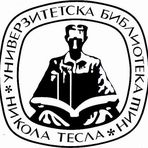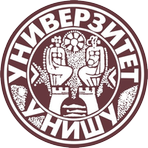Title
Strukturna karakterizacija CaMnOз nanoprahova dopiranih itrijumom i teorijsko modelovanje stabilnosti perovskitske strukture : doktorska disertacija
Creator
Zagorac, Jelena B. 1979-
Copyright date
2014
Object Links
Select license
Autorstvo-Nekomercijalno-Deliti pod istim uslovima 3.0 Srbija (CC BY-NC-SA 3.0)
License description
Dozvoljavate umnožavanje, distribuciju i javno saopštavanje dela, i prerade, ako se navede ime autora na način odredjen od strane autora ili davaoca licence i ako se prerada distribuira pod istom ili sličnom licencom. Ova licenca ne dozvoljava komercijalnu upotrebu dela i prerada. Osnovni opis Licence: http://creativecommons.org/licenses/by-nc-sa/3.0/rs/deed.sr_LATN Sadržaj ugovora u celini: http://creativecommons.org/licenses/by-nc-sa/3.0/rs/legalcode.sr-Latn
Language
Serbian
Cobiss-ID
Theses Type
PhD thesis
Other responsibilities
mentor
Zarubica, Aleksandra 1975-
član komisije
Bojić, Aleksandar 1966-
član komisije
Ranđelović, Marjan 1982-
član komisije
Matović, Branko
Academic Expertise
Prirodno-matematičke nauke
Academic Title
-
University
Univerzitet u Nišu
Faculty
Prirodno-matematički fakultet
Group
Odsek za hemiju
Title translated
STRUCTURAL CHARACTERIZATION OF THE YTTRIUM DOPED CaMnO3 NANOPOWDERS AND THEORETICAL MODELLING OF THE PEROVSKITE STRUCTURE STABILITY
Publisher
Niš : [J. B. Zagorac]
Format
PDF/A (187 listova)
description
Umnoženo za odbranu.
Univerzitet u Nišu, Prirodno-matematički fakultet, Departman za hemiju, 2014.
Bibliografija: listovi 136-160.
Rezime ; Summary.
description
Applied chemistry, Material science
Abstract (en)
In the first part of dissertation structural, microstructural and phase analysis of
the nanopowders with the general formula Ca1-xYxMnO3 (0 ≤ x ≤ 1) were performed
using XRPD diffraction technique and Rietveld refinement. The most abundant
crystal phases in these nanopowders are the members of ABO3 solid solutions with the
perovskite structure type. Seven nanopowders of nominal composition CaMnO3
(Ca100), Ca0.95Y0.05MnO3 (Ca95), Ca0.85Y0.15MnO3 (Ca85), Ca0.75Y0.25MnO3 (Ca75),
Ca0.5Y0.5MnO3 (Ca50), Ca0.25Y0.75MnO3 (Ca25) and YMnO3 (Y100) were prepared
using a modified glycine/nitrate process. Yttrium doped CaMnO3 crystallizes in the
space group Pnma, and one of the goals of the research is to investigate the stability of
the perovskite structure type depending on the dopant concentration. Two phase
composition of all samples and amount of each phase was revealed using XRPD
diffraction and Rietveld refinement. The most abundant phase in all samples has the
perovskite structure type. As a result of doping with Y, the XRPD analysis showed
that all the perovskite phases are deformed, with symmetry reduced from cubic to
orthorhombic, and that they crystallize in the Pnma space group. Unit cell parameters
analysis showed that the increase of the unit cell parameters, which is related to the
higher amount of Y in the structure, is a consequence of reduction of Mn4+ to Mn3+.
Besides the reduction of the Mn and the effect of doping with Y, presence of
vacancies in the structure also affects the mechanism of this transformation. The
chemical compositions, calculated from the refined occupancy values, are compared
with nominal compositions. Effect of yttrium on the bond lengths and bond angles,
tilting and deformation of octahedra caused by presence of Mn3+ and Jahn-Teller
effect, was analyzed. In order to investigate the coordination of the A and B sites,
bond valence analysis was performed. In addition, concentration of yttrium in the
doped perovskite phases was investigated using X-ray photoelectron spectroscopy
(XPS).
In the second part of dissertation we have performed a crystal structure
prediction study of CaMnO3 focusing on structures generated by octahedral tilting
according to group-subgroup relations from the ideal perovskite type ( Pm3m), which
173
is the aristotype of the experimentally known CaMnO3 compound in the Pnma space
group. Using software SPuDS we obtained initial structure parameters for most of the
perovskite structure candidates. Furthermore, additional structure candidates have
been obtained using data mining. For each of the structure candidates, a local
optimization on the ab initio level using density functional theory (LDA and hybrid
B3LYP) and the Hartree-Fock (HF) method was performed, and we find that several
of the modifications may be experimentally accessible. In the high-pressure regime,
we have identified a post-perovskite phase in the CaIrO3 type, not previously
observed in CaMnO3. Similarly, calculations at negative pressure predicted a phase
transition from the orthorhombic perovskite to an ilmenite-type (FeTiO3) modification
of CaMnO3.
Authors Key words
Nanoprahovi, CaMnO3, dopiranje, itrijum, strukturna karakterizacija, perovskit, teorijsko modelovanje
Authors Key words
XRPD diffraction, Rietveld refinement, modified glycine/nitrate
process, nanopowders CaMnO3, X-ray photoelectron spectroscopy, ab initio methods,
post-perovskite
Classification
62
Subject
66
Subject
54
Type
Elektronska teza
Abstract (en)
In the first part of dissertation structural, microstructural and phase analysis of
the nanopowders with the general formula Ca1-xYxMnO3 (0 ≤ x ≤ 1) were performed
using XRPD diffraction technique and Rietveld refinement. The most abundant
crystal phases in these nanopowders are the members of ABO3 solid solutions with the
perovskite structure type. Seven nanopowders of nominal composition CaMnO3
(Ca100), Ca0.95Y0.05MnO3 (Ca95), Ca0.85Y0.15MnO3 (Ca85), Ca0.75Y0.25MnO3 (Ca75),
Ca0.5Y0.5MnO3 (Ca50), Ca0.25Y0.75MnO3 (Ca25) and YMnO3 (Y100) were prepared
using a modified glycine/nitrate process. Yttrium doped CaMnO3 crystallizes in the
space group Pnma, and one of the goals of the research is to investigate the stability of
the perovskite structure type depending on the dopant concentration. Two phase
composition of all samples and amount of each phase was revealed using XRPD
diffraction and Rietveld refinement. The most abundant phase in all samples has the
perovskite structure type. As a result of doping with Y, the XRPD analysis showed
that all the perovskite phases are deformed, with symmetry reduced from cubic to
orthorhombic, and that they crystallize in the Pnma space group. Unit cell parameters
analysis showed that the increase of the unit cell parameters, which is related to the
higher amount of Y in the structure, is a consequence of reduction of Mn4+ to Mn3+.
Besides the reduction of the Mn and the effect of doping with Y, presence of
vacancies in the structure also affects the mechanism of this transformation. The
chemical compositions, calculated from the refined occupancy values, are compared
with nominal compositions. Effect of yttrium on the bond lengths and bond angles,
tilting and deformation of octahedra caused by presence of Mn3+ and Jahn-Teller
effect, was analyzed. In order to investigate the coordination of the A and B sites,
bond valence analysis was performed. In addition, concentration of yttrium in the
doped perovskite phases was investigated using X-ray photoelectron spectroscopy
(XPS).
In the second part of dissertation we have performed a crystal structure
prediction study of CaMnO3 focusing on structures generated by octahedral tilting
according to group-subgroup relations from the ideal perovskite type ( Pm3m), which
173
is the aristotype of the experimentally known CaMnO3 compound in the Pnma space
group. Using software SPuDS we obtained initial structure parameters for most of the
perovskite structure candidates. Furthermore, additional structure candidates have
been obtained using data mining. For each of the structure candidates, a local
optimization on the ab initio level using density functional theory (LDA and hybrid
B3LYP) and the Hartree-Fock (HF) method was performed, and we find that several
of the modifications may be experimentally accessible. In the high-pressure regime,
we have identified a post-perovskite phase in the CaIrO3 type, not previously
observed in CaMnO3. Similarly, calculations at negative pressure predicted a phase
transition from the orthorhombic perovskite to an ilmenite-type (FeTiO3) modification
of CaMnO3.
“Data exchange” service offers individual users metadata transfer in several different formats. Citation formats are offered for transfers in texts as for the transfer into internet pages. Citation formats include permanent links that guarantee access to cited sources. For use are commonly structured metadata schemes : Dublin Core xml and ETUB-MS xml, local adaptation of international ETD-MS scheme intended for use in academic documents.


